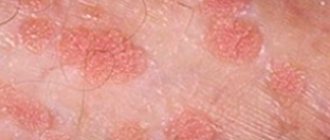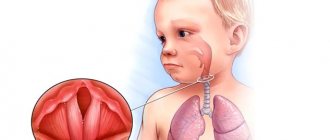Causes of whooping cough
Whooping cough is transmitted by airborne droplets. The incubation period ranges from 3 to 14 days (usually 5-7 days). The causative agent of whooping cough quickly dies in the external environment. Therefore, for example, for the room where the patient was, no special treatment is required - it is enough to ventilate it properly, and simply wash the dishes and toys with soap.
However, whooping cough is a highly contagious disease. When in contact with a sick person (a distance of 2 meters is considered critical), the probability of becoming infected is very high (more than 70%). The smallest particles of mucus that carry the infection fly out when the child coughs, talks, or cries and enters the respiratory system with the air.
The prevalence of whooping cough is also facilitated by the fact that the disease often occurs in a blurred form. In a similar way, whooping cough occurs in adults or against the background of vaccination. An infection that causes a habitual and harmless cough in an adult, if transmitted to a child who does not have immunity to whooping cough, can cause a typical form of the disease in him. Even a newborn can get sick, since antibodies to the causative agent of whooping cough are not transmitted from mother to child.
The patient is contagious from the 1st to the 25th day of illness. However, with timely treatment, the duration of the infectious period can be reduced.
Complications
In severe cases of the disease, there is a high risk of developing a number of extremely dangerous complications:
- Hemorrhages in the spinal cord and brain, in the sclera of the eyes, on the surface of the skin of the face, bleeding from the nose;
- Impaired proper functioning of the lungs (emphysema);
- Airway rupture;
- Formation of hemorrhoids, protrusion of the rectum and umbilical or inguinal hernias;
- Associated infections due to weakened immunity.
Whooping cough symptoms
The onset of the disease resembles a common acute respiratory infection: the temperature rises slightly, nasal discharge appears, and a rare dry cough. Subsequently, the cough intensifies, becoming spasmodic in nature.
Runny nose
Whooping cough usually begins with the appearance of mucous discharge from the nose. They may appear even before the temperature rises. The child begins to sneeze and cough.
More about the symptom
Temperature
At the onset of the disease, as a rule, there is a slight increase in temperature - up to 37-37.5 ° C.
More about the symptom
Cough
At the first stage of the disease, the cough is dry and rare. Traditional methods of treating cough for whooping cough for ARVI do not help, the cough gradually intensifies. After 10-14 days from the onset of the disease, spasmodic coughing attacks typical of whooping cough are observed.
Such an attack looks like a series of coughing shocks, followed by a deep wheezing breath. Then - new coughing tremors. This cycle can be repeated several times (from 2 to 15 - depending on the severity of the disease). The cough is not easy; The child’s face may turn blue and the neck veins may swell. He sticks out his tongue; this may cause injury to the frenulum of the tongue. Infants may stop breathing. The attack ends with the release of a small amount of glassy sputum or vomiting. The number of such attacks can reach up to 50 per day.
The period of spasmodic cough lasts 3-4 weeks. After this, the cough (already normal, not spasmodic) persists for another 2-3 weeks.
More about the symptom
Diagnostics
When visiting a medical clinic, the doctor first assesses the external manifestations of the disease and collects anamnesis. The presence of a prolonged paroxysmal cough that cannot be treated with antitussive drugs is a reason to suspect infection with pertussis bacillus. For additional diagnosis of whooping cough, the doctor prescribes a whooping cough test.
- PCR diagnostics. Testing is carried out during the first month of the disease. To collect biomaterial, the person being tested comes to the clinic on an empty stomach, a swab is taken from the oropharynx and nose, and after some time an answer is received about the presence or absence of infection.
- Clinical blood test. This diagnostic method is less informative than PCR and allows you to determine the presence of an inflammatory process in the body, but what caused this remains unknown.
- Sowing for microflora. This method is effective only in the first days of the disease. A swab from the oropharynx is taken from the patient on an empty stomach and the biomaterial is taken again the next day or every other day. The result can be found out in 5-7 days.
- Antibody detection test. 2-3 weeks after the onset of the disease, the body produces antibodies to whooping cough, which can be detected by taking the patient’s blood for analysis.
Treatment methods for whooping cough
The causative agent of whooping cough is sensitive to antibiotics only at the beginning of the disease (before the period of spasmodic cough). If the disease has already entered this phase, treatment is aimed mainly at reducing the frequency and severity of attacks. To do this, if possible, eliminate the influence of irritating agents that cause coughing. The child needs to spend more time in the fresh air and be in a ventilated area. It is also important to relieve the allergic reaction caused by toxins produced by the causative bacteria.
The younger the sick child, the more severe the disease. Even death is possible. Therefore, it is very important to protect your child by vaccinating him against whooping cough. Even if the vaccinated child subsequently gets sick (there is such a possibility), his disease will proceed in a smoothed form, without painful spasmodic attacks.
Drug treatment
Antibiotics kill the causative agent of whooping cough. However, as a rule, this occurs relatively late, since whooping cough is often not recognized at the onset of the disease. By the time antibiotics are used, the pathogen usually already affects the cough receptors in the brain. Therefore, the cough continues even after the destruction of the whooping cough bacillus.
Expectorants, antihistamines, sedatives and other drugs can also be used in the treatment of whooping cough. Their action is aimed at preventing possible complications, but they cannot speed up relief from cough.
Vaccination
Vaccination against whooping cough is included in the National and Regional calendars of preventive vaccinations; immunization of children begins at 3 months of age and consists of several sequential vaccinations. By contacting Family Doctor JSC about immunization against whooping cough, you guarantee that the vaccine will be of adequate quality, and the actions of medical personnel will be professional and qualified.
You should consult a pediatrician about vaccinating your child against whooping cough.
More information about the treatment method
Make an appointment Do not self-medicate. Contact our specialists who will correctly diagnose and prescribe treatment.
Rate how useful the material was
thank you for rating
Prevention
To prevent the disease, pertussis-diphtheria-tetanus vaccination has been carried out all over the world for many years. In 1940-1948, there was a high mortality rate from this disease among young children, but the invention of vaccination helped reduce the number of deaths by 45 times. It is recommended to be vaccinated several times throughout life, and the first vaccination is given to a pregnant woman in the third trimester of pregnancy. Vaccination against whooping cough does not provide an unambiguous guarantee of avoiding infection, but the disease is much milder and with fewer complications, and the mortality rate from whooping cough worldwide is 45 times lower compared to unvaccinated people.
Rare side effects of whooping cough vaccine
There are almost no side effects when administering the whooping cough vaccine. In extremely rare cases, mild side effects are possible. This includes fever, vomiting, redness, swelling, or tenderness where the needle enters. Even less common are more serious side effects, such as a temperature above 40.5 ° C, crying for several hours, and behavioral disturbances. If your child experiences any of the above side effects after vaccination, contact your doctor immediately.
Sick leave during quarantine due to whooping cough epidemic
Clause 48 of the Order of the Ministry of Health dated September 1, 2020 No. 925-states that during quarantine for whooping cough, citizens are issued sick leaves. They are prepared not only by infectious disease doctors, but also by paramedics. The sick leave is valid for the entire period of isolation of the person who has been suspended from work.
A certificate of incapacity for work during quarantine is issued to parents who have children under 7 years of age in their family. At the same time, it is not possible to issue sick leave during restrictive measures to those parents who have children over 7 years old.
In a situation where a doctor refuses to issue a certificate of incapacity for work due to quarantine for whooping cough, you must contact a higher authority. For local clinics this is the Department of Health. If this body refuses to resolve the issue, then you should contact the territorial division of Roszdravnadzor with a complaint about the unlawful refusal.
Vaccination against whooping cough. What are the problems?
Does this mean that all children in the Russian Federation are vaccinated against whooping cough? Unfortunately no. We will not touch here on the problem of some “religious” or other non-scientific reasons for refusing vaccinations.
We are interested in the question: are there medical contraindications to DPT vaccination in children?
Answer: yes, they exist.
According to current clinical recommendations, unvaccinated children with atopic dermatitis, as well as those who often suffer from respiratory diseases, are vaccinated with toxoids ADS or ADS-M without the pertussis component, which is conventionally considered “guilty” in the development of most unwanted side effects from vaccination, such as: prolonged fever (increased temperature body), allergic reactions, seizures. Why conditionally guilty?
This is difficult to prove.
So, we have a certain, fairly large group of children with an official medical exemption from DTP vaccination.
It is logical to assume that a fairly large group of unvaccinated children is at increased risk of contracting whooping cough, and if they visit an organized group, they can also become a source of an epidemic outbreak of this disease.
What should I do?
Nuances
During quarantine for whooping cough, vaccination is not carried out. Due to the high susceptibility of newborns to infection, immunoglobulin administration is indicated. The vaccination is done in maternity hospitals. Vaccination is also carried out in the first three months of a newborn’s life. The vaccine is also given to unvaccinated children whose age does not exceed one year. In all cases, the administration of immunoglobulin is indicated in cases where the newborn has been in contact with a sick person. Vaccination of children is carried out only with the prior consent of their parents.
Comments Showing 0 of 0
In what cases are quarantine measures announced in preschool educational institutions and schools?
Since whooping cough is an infectious disease , one case in a group or class is enough to declare a quarantine.
A school is closed for quarantine if 30% of students are infected.
The main document regulating quarantine measures in schools and kindergartens in the event of cases of whooping cough is SanPiN 3.1.2.3162-14 “Prevention of whooping cough” dated March 17, 2014.
QUOTE: 7.8 . In preschool educational and general education organizations, special educational institutions of open and closed type, children's recreation and health organizations, organizations for orphans and children left without parental care, orphanages, sanatoriums for children, children's hospitals, maternity hospitals (departments) When secondary cases of the disease appear, medical observation is carried out until the 21st day from the moment of isolation of the last sick person.
It will be useful for parents to familiarize themselves with the procedure for carrying out quarantine measures in school and kindergarten in connection with diseases such as mononucleosis, viral pneumonia, chickenpox, scarlet fever, acute intestinal infection, E. coli, enterovirus and enterocolitis, rotavirus and gastroenteritis.
Whooping cough, history of the study of the disease
Doctors have known whooping cough for a long time. For the first time, a disease accompanied by symptoms of convulsive cough was described in the 16th century during an epidemic of this disease in Paris. In 1847, a description of whooping cough was compiled by the Russian scientist Stepan Fomich Khotovitsky.
The undeservedly forgotten founder of the science of childhood diseases in Russia and the author of the first Russian textbook on Pediatrics S.F. Khotovitsky divided his childhood into three periods. According to Khotovitsky’s classification, diseases of the “second period of childhood” included: “inflammatory suffering of the brain, larynx, lungs, peritoneum, intestines, spinal cord, whooping cough.”
So, we see that already in the 19th century, pediatricians considered whooping cough as a serious disease of early and middle childhood.







